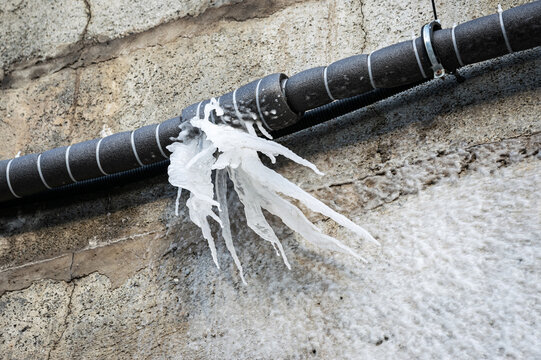The author is making a few great pointers relating to How to Prevent Your Pipes From Freezing as a whole in this article below.

Winter can wreak havoc on your plumbing, particularly by freezing pipes. Here's how to prevent it from happening and what to do if it does.
Intro
As temperatures drop, the risk of icy pipelines boosts, potentially resulting in costly fixings and water damages. Comprehending exactly how to avoid frozen pipelines is important for property owners in cool climates.
Prevention Tips
Protecting vulnerable pipelines
Wrap pipes in insulation sleeves or make use of heat tape to secure them from freezing temperatures. Concentrate on pipelines in unheated or exterior locations of the home.
Home heating techniques
Maintain interior rooms sufficiently warmed, especially locations with pipes. Open up closet doors to permit cozy air to flow around pipelines under sinks.
Just how to identify frozen pipes
Look for decreased water circulation from taps, uncommon odors or noises from pipes, and noticeable frost on revealed pipes.
Long-Term Solutions
Architectural changes
Think about rerouting pipes away from outside wall surfaces or unheated locations. Include additional insulation to attic rooms, basements, and crawl spaces.
Upgrading insulation
Purchase top notch insulation for pipes, attic rooms, and walls. Proper insulation helps keep constant temperature levels and reduces the risk of frozen pipes.
Protecting Exterior Plumbing
Yard pipes and outdoor taps
Disconnect and drain pipes garden pipes before winter months. Set up frost-proof faucets or cover outdoor taps with shielded caps.
Comprehending Icy Pipes
What triggers pipelines to ice up?
Pipelines freeze when subjected to temperature levels below 32 ° F (0 ° C) for prolonged durations. As water inside the pipelines freezes, it expands, putting pressure on the pipeline walls and potentially triggering them to break.
Threats and problems
Frozen pipes can result in water system disturbances, home damage, and pricey repairs. Ruptured pipelines can flood homes and cause extensive architectural damages.
Indications of Frozen Pipeline
Identifying icy pipes early can avoid them from rupturing.
What to Do If Your Pipes Freeze
Immediate activities to take
If you think icy pipelines, keep taps open to relieve stress as the ice thaws. Utilize a hairdryer or towels taken in warm water to thaw pipes gradually.
Final thought
Stopping icy pipelines calls for proactive procedures and quick actions. By understanding the reasons, indicators, and preventive measures, homeowners can shield their plumbing during winter.
6 Proven Ways to Prevent Frozen Pipes and Protect Your Home
Disconnect and Drain Garden Hoses
Before winter arrives, start by disconnecting your garden hoses and draining any remaining water. Close the shut-off valves that supply outdoor hose bibs and leave the outdoor faucet open to allow any residual water to drain. For extra protection, consider using faucet covers throughout the colder months. It’s also important to drain water from any sprinkler supply lines following the manufacturer’s directions.
Insulate Exposed Pipes
Insulating your pipes is an effective way to prevent freezing. Pipe insulation is readily available at home improvement stores and is relatively inexpensive. Pay close attention to pipes in unheated areas such as the attic, basement, crawl spaces, or garage. Apply foam insulation generously to create a buffer against the cold. You can also wrap your pipes in heat tape or thermostat-controlled heat cables for added warmth.
Seal Air Leaks
Inspect your home for any cracks or openings that could let in cold air. Seal any holes around the piping in interior or exterior walls, as well as the sill plates where your home rests on its foundation. Additionally, make sure to keep your garage door closed unless you’re entering or exiting. Leaving it open creates a significant air leak that can lead to frozen pipes.
Allow Warm Air Circulation
During cold snaps, it’s essential to allow warm air to circulate evenly throughout your home. Leave interior doors ajar to promote better airflow. Open kitchen and bathroom cabinets to help distribute heat consistently around the rooms. If you have small children or pets, be sure to remove any household chemicals or potentially harmful cleaners from open cabinets for safety.
Let Faucets Drip
A small trickle of water can make a big difference in preventing ice formation inside your pipes. When temperatures drop significantly, start a drip of water from all faucets served by exposed pipes. This continuous flow helps prevent the water from freezing. Additionally, running a few faucets slightly can relieve pressure inside the pipes, reducing the chances of a rupture if the water inside does freeze.
https://choateshvac.com/6-proven-ways-to-prevent-frozen-pipes-and-protect-your-home/

We were shown that report about 6 Ways to Prevent Frozen Pipes through a friend on another domain. So long as you enjoyed our blog post please don't forget to share it. Thank you for your time. Come back soon.
Call Today
Comments on “Important Tips to Avoid Frozen Pipes in Cold Weather: Professional Insights”